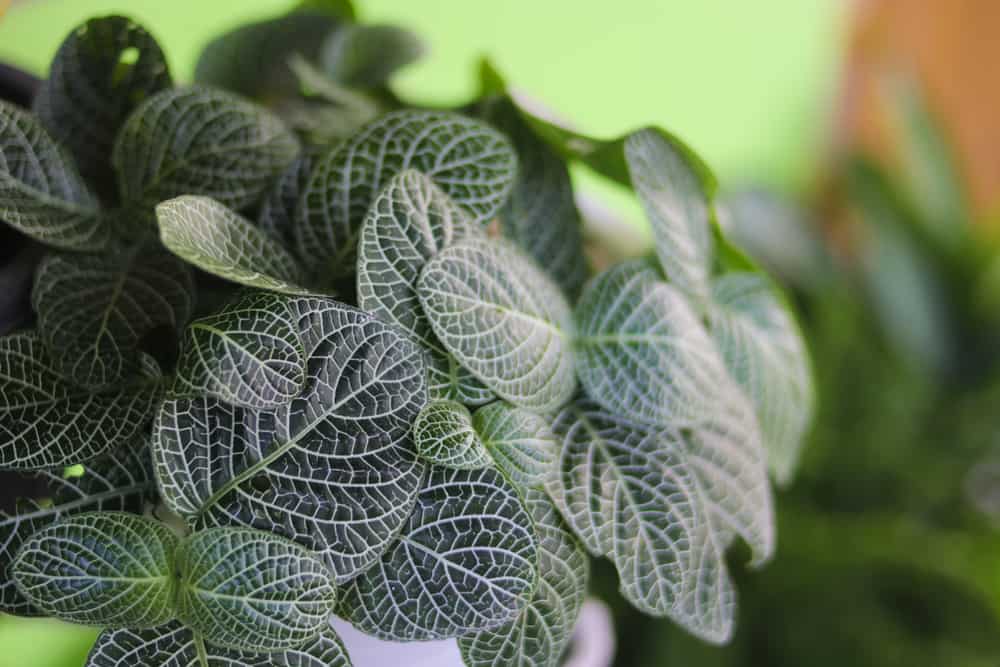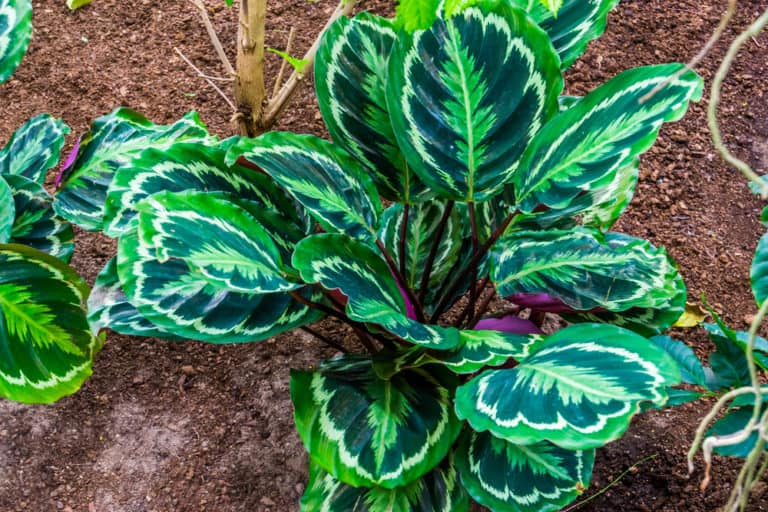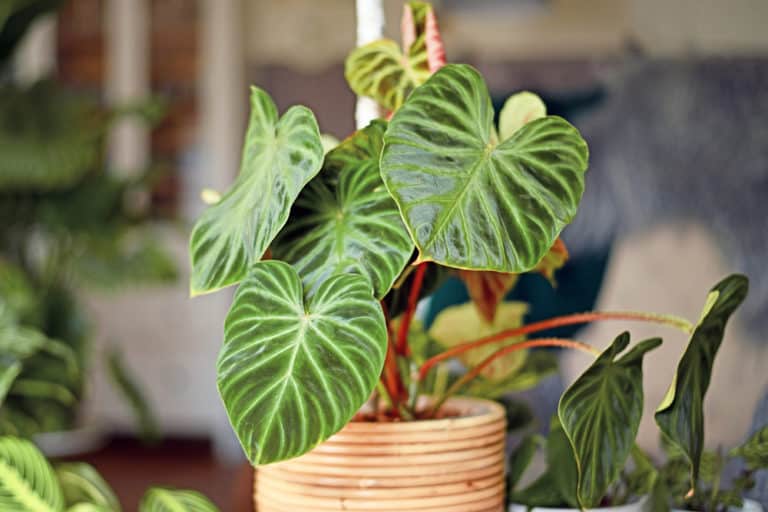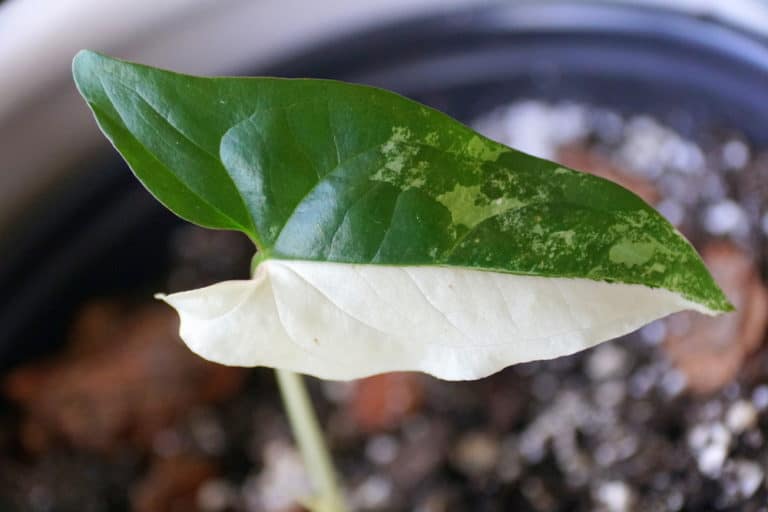Fittonia Argyroneura ‘Nerve Plant’ Care Guide (2024)

The nerve plant, or Fittonia argyroneura, is a small but sharp-looking evergreen tropical plant that will fit in just about anywhere.
While it can be a little demanding in its growing requirements, its leaves with their white or silver veins will make a big impact when used indoors or outside.
| Scientific Name | Fittonia argyroneura |
| Common Name | Nerve plant, mosaic plant, painted net leaf |
| Light | Bright indirect sunlight |
| Watering | Water if the surface of the soil is dry |
| Temperature | 60 to 80ºF (16 to 26ºC) |
| Hardiness Zone | 11 to 12 |
| Humidity | 60 to 90% |
| Soil Type | Rich, quick-draining, loamy |
| Soil pH | 6.5 (mildly acidic) |
| Fertilizing | A balanced feed once a month in spring and summer |
| Repotting | Every 1 to 2 years |
| Pruning | As needed |
| Propagation | Root in water or soil |
| Toxicity | Not toxic to humans and pets |
| Mature Size | 3 to 6 inches as a houseplant |
| Bloom Time | Summer |
What’s Unique About Nerve Plant?
The nerve plant, also known as Fittonia albivenis or Fittonia argyroneura, is native to the tropical rainforests of the Andes. Its range includes parts of Peru, Bolivia, Brazil, Colombia, Venezuela and Ecuador.
Nerve plants never grow taller than 6 inches, so they can be used in even the smallest city apartment to add a dash of color.
Growing nerve plant isn’t too challenging, as long as you pay attention to its need for moist soil and high humidity levels.
Not only will you be rewarded with a gorgeous display of leaves, but your nerve plant will also clear the air of the harmful chemical toluene.
Nerve Plant Care
In the rainforests of the Andes where Fittonia argyroneura originates, this diminutive plant lives on the forest floor, spreading into dense mats.
Your nerve plant care should aim to reproduce its native habitat as closely as possible, without turning your home into a tropical rainforest.
Good Fittonia argyroneura care needs to focus on keeping your plant well-watered in a warm, humid environment.
Light
In the tropical rainforests of the Andes, Fittonia argyroneura grows along the forest floor, shaded from the brilliant equatorial sun by the tree canopy.
In your home, nerve plant light requirements are for bright, indirect light, or about 15,000 to 25,000 lux.
Fittonia argyroneura light needs can usually be accommodated without using fluorescent or LED grow lights, but if all you have is a north window, you might find them necessary.
Otherwise, find a spot for your nerve plant next to an east window, or several feet back from a south or west-facing window.
Always keep your Fittonia argyroneura out of the full sun, as it will burn the delicate leaves.
Watering
In its rainforest home, Fittonia argyroneura is used to consistently moist soil that drains well, so it needs the same in your home.
Don’t do your nerve plant watering on a fixed schedule, but rather check the soil moisture every day or two.
You should water Fittonia argyroneura whenever the surface of the soil is dry to the touch.
Either slowly pour tepid water over the surface or soak the pot in water and then let all the excess drain away.
Water less often during its winter dormant period.
You will know if you are not fulfilling the watering needs of your nerve plant, as they are notorious for collapsing dramatically when too dry.
However, they soon bounce back after a good soaking.
Temperature
The nerve plant temperature range is from 60 to 80ºF (16 to 26ºC).
On the whole, the best temperature for Fittonia argyroneura is about 70ºF (21ºC), so your indoor temperatures should be just about right for your nerve plant.
Once you get below that range, however, Fittonia argyroneura has very little temperature tolerance.
Even a draft or cold window in an otherwise warm house can spell disaster for this tropical plant.
And while you can move your Fittonia argyroneura outdoors for the steamy summer weather, it has absolutely no frost hardiness.
Bring it back in long before cooler weather arrives.
Humidity
The equatorial rainforests of the Andes have high humidity levels, rarely falling below 80%, and the nerve plant humidity requirements reflect their native habitat.
The ideal humidity for Fittonia argyroneura is between 60 to 90%, which is certainly higher than any home should be kept at.
To provide your Fittonia argyroneura with an adequate humidity level, you are going to have to create a suitable microclimate in its immediate vicinity.
Consider a terrarium for your nerve plant, as the enclosed space will keep the moist air where it’s needed.
Misting twice a day will work, but can get tedious. Investing in a small humidifier for your tropical plants is a better long-term solution.
Soil
In the rainforest, the Fittonia argyroneura grows in spongy soil that has been enriched with decayed vegetation.
Your nerve plant soil should be porous with lots of organic matter. It has to not only retain moisture, but also drain excess water.
The best pH level for Fittonia argyroneura is 6.5, or slightly acidic.
The best commercially available soil for Fittonia argyroneura is an African Violet soil mix. It’s pretty easy to find.
However, you can also use a standard houseplant potting soil. Just be sure to add some extra perlite or peat moss to make sure that it will drain well.
Fertilizer
It is important only to use nerve plant fertilizer in spring and summer, during the active growing season.
Use a standard liquid fertilizer for Fittonia argyroneura with a fertilizer ratio of 5-5-5. Dilute it to half strength.
Once a month, right after you’ve watered your Fittonia argyroneura, pour the fertilizer solution evenly over the entire soil surface.
If you see a white crust on the soil surface, that’s accumulated fertilizer salts that can harm your nerve plant.
Flush the salts out of the soil by running a stream of water through it for about 10 minutes, and then let the pot drain thoroughly.
Potting & Repotting
Nerve plant repotting should be done every 1 or 2 years, preferably early in the spring.
Even if your Fittonia argyroneura isn’t rootbound, periodically refreshing the potting soil will help keep it healthy.
Of course, if you see roots coming out of the holes, it’s definitely time for a new pot.
When repotting Fittonia argyroneura, only go up one pot size, as too big a pot can actually harm your nerve plant.
Choose a glazed pot to help conserve soil moisture, and make sure it’s got drainage holes.
Fittonia argyroneura has shallow roots, so you shouldn’t use a deep pot, or you’ll have too much soil.
Pruning
Nerve plant pruning can be done at any time during the year to neaten up your Fittonia argyroneura.
You can snip off the growing tips of stems that are getting too leggy for your tastes.
You won’t see new growth developing out from that point, but it will improve the overall shape of your Fittonia argyroneura.
The other reason for cutting Fittonia argyroneura is to get rid of dead or damaged leaves.
Not only do they detract from the appearance of your nerve plant, but damaged vegetation can invite disease and insects.
To trim your Fittonia argyroneura, always use sharp sterilized scissors.
Propagation
Nerve plant propagation is remarkably easy to do.
In its natural rainforest setting, Fittonia argyroneura spreads by nodes rooting themselves in the soil, and you can adapt that same method to propagate Fittonia argyroneura.
Cut stem tips with at least 2 nodes and a few leaves. Strip all but the top leaves off and put the cuttings in a jar of water or moist soil. In less than a month they will grow new roots.
You can also layer stems. Simply pin down a stem to the soil, making sure that a node is in contact with the soil.
New roots will grow at the node, and a new stem and leaves will grow up. Separate the new plant by cutting the original stem, and pot it up separately.
Common Problems of Nerve Plant
Most nerve plant problems can be avoided if you maintain proper growing conditions.
However, if you do encounter some problems with Fittonia argyroneura, you should be able to resolve them.
As long as the leaves look good, you probably have nothing to worry about, but if they start to look under the weather, it’s time to start searching for the cause.
Pests
Most nerve plant pests will be familiar to any experienced indoor gardener.
You can usually keep bugs away from your Fittonia argyroneura by spraying or wiping down its leaves once a month with an insecticidal soap or neem oil mixture.
Spider mites leave little yellow bumps on the leaves, along with their webs.
Aphids are small, green flying insects under the leaves and on the stems.
Give your Fittonia argyroneura foliage a good shower to knock both of these bugs off.
Mealybugs congregate under the leaves and look like little tufts of cotton. Wipe them away with a cotton ball soaked in rubbing alcohol.
Fungus gnats are little black flies. Set yellow sticky traps to catch adults, and drench the soil with a mixture of 1 part hydrogen peroxide to 4 parts water.
Diseases
Most nerve plant diseases take advantage of wet conditions to get established.
While you need to improve your watering habits, that will not be enough to eliminate existing diseases affecting your Fittonia argyroneura.
Root rot is very likely when your Fittonia argyroneura’s soil is too wet. If the leaves are yellowing and the stems are mushy, check the roots. If they are turning black, that is root rot.
Cut off everything that is affected, and replant your nerve plant in fresh soil in a disinfected pot.
Leaf spot can be a fungal or bacterial disease caused by water left on the leaves. Cut off all affected leaves and stems, and do not get water on the leaves.
Growing Problems
Your Fittonia argyroneura may have growing problems that are just the result of poor growing conditions. Fix them and your sick plant should recover.
If your nerve plant’s leaves are dropping off, it is probably being exposed to too-cold temperatures.
Make sure that it’s not sitting in a draft or by a cold window in winter, or next to an air conditioning vent in summer.
Dry, shriveled leaves may mean low humidity or too much sun. You may need to move into a shadier spot, or give it a more moisture-rich environment.
Consider moving it to your bathroom to let it enjoy the extra humidity.
Toxicity of Nerve Plant
Fittonia argyroneura is not at all toxic to people or animals, which is good news to the parents of children or pets!
However, just because nerve plants have no toxicity, that does not mean that your kids or pets should be given access to these plants.
It’s not a good idea for either them or your Fittonia argyroneura.
For Humans
Fittonia argyroneura is not toxic to humans, so you do not have to take any precautions such as wearing gloves while working with your nerve plant.
However, you should still not let your children handle your Fittonia argyroneura.
In the first place, you don’t want your precious plant subjected to possible rough treatment at the hands of a toddler.
Even more importantly, you may be using insecticides and fertilizers on your Fittonia argyroneura that your children should not be exposed to.
Finally, young children won’t be able to tell which plants are safe and which ones are toxic, so it’s best just to call them all off-limits.
For Pets
Fittonia argyroneura is not toxic to pets, but that doesn’t mean that your cat and dog might not have an adverse reaction to eating its foliage.
Canines and felines are carnivores. Their digestive systems are not equipped to handle much in the way of vegetative matter.
If your cat or dog eats too much of your nerve plant’s leaves, they could end up with vomiting and diarrhea for several hours. You could be in for a very messy and unpleasant time.
Luckily, Fittonia argyroneura is perfectly suited to growing as a hanging plant or on a high shelf or mantle where your pets will not be able to get to it.
Nerve Plant Appearance
While there are several different varieties in the Fittonia argyroneura group, they all share a common nerve plant appearance.
These nerve plants all feature white or silver veins against a green background. Varieties include White Dwarf and White Angel, which both have highly defined white veins.
White Star’s leaves can sometimes look almost entirely white with a narrow green edging.
Foliage
The foliage of nerve plant is vibrant, guaranteed to add a dash of pizzazz wherever you use them.
No matter what the variety, a Fittonia argyroneura leaf is a deep olive with an intricate pattern of veins of white or silver.
Leaves are ovate, and can be as long as 4.5 inches. They grow in an opposite arrangement on the stems.
The leaves are delicate and paper-thin, with a smooth, velvety surface.
Since Fittonia argyroneura is an evergreen perennial and the leaves last a long time, you should wipe them down once a month to keep them from getting dusty.
Flowering
While the Fittonia argyroneura flower can be seen, even on plants grown indoors, nerve plant flowering is less than overwhelming.
In fact, many growers cut off flower stems to prevent their Fittonia argyroneura from blooming.
When flowers do bloom, they are spikes of cream or yellow flowers that emerge in early summer. They can be up to 3 inches long.
The flowers have no fragrance.
You are more likely to have a flowering Fittonia argyroneura if you are growing it outside in a tropical climate where it can thrive year-round.
However, since the foliage is so attractive you will not miss these insignificant blooms.
Size and Growth
The small size of nerve plant makes this tropical houseplant ideal for even the smallest living or working space.
A mature Fittonia argyroneura plant will only reach a height of 3 to 6 inches, although its trailing stems can spread 12 to 18 inches.
Nerve plants generally have a slow growth rate and can take as much as 5 years to reach their full size.
Fittonia argyroneura plants will grow into a bushy, dense clump, with stems that will spill down.
You can pinch the stem tips to keep them short, or allow them to grow to their full extent.
Nerve Plant Fragrance
There is no nerve plant fragrance. The evergreen foliage has no scent, and even the rare flowers have no fragrance.
However, Fittonia argyroneura is great at improving the air quality indoors. Its foliage has been proven to be effective at filtering out toluene, a harmful chemical found in products such as nail polish and glues.
As well, since nerve plant is non-toxic as well as fragrance-free, it can be used in a variety of public settings where people with sensitivities to scents might be exposed to it.
Even in your own home, if it’s a small studio apartment or tiny house, a petite plant with no overwhelming smell might be preferable.
Suggested Uses for Nerve Plant
There are so many great ways to use Fittonia argyroneura in your home or office.
Because it’s so small, you can easily find a spot for almost anywhere indoors.
A hanging planter of nerve plant is perfect for a bathroom, where its high humidity will be of benefit to your Fittonia argyroneura as it brightens the space.
Keep a Fittonia argyroneura next to your dressing table to filter fumes from your nail polish.
You can also move nerve plants outside to a balcony or patio in summer, where they can form part of a temporary tropical garden.
If you live in a tropical climate, Fittonia argyroneura can be grown as a ground cover or bedding plant.
FAQ
What is nerve plant?
The nerve plant is an evergreen perennial native to the rainforests of the Andes along the equator. It is commonly grown as a houseplant for its vibrant foliage.
How to identify nerve plant?
The nerve plant has ovate leaves up to 4.5 inches long, dark olive with a pattern of bright white or silver veins. They grow on a small plant with short trailing stems.
How to care for nerve plant?
The nerve plant should be kept in bright, indirect light in a warm and very humid environment, in consistently moist soil, with regular light fertilizing.
How to grow nerve plant indoors?
The nerve plant can be grown indoors as a potted plant year-round in temperate zones, as long as it is kept at normal room temperatures and protected from drafts.
How to grow nerve plant outdoors?
The nerve plant can be grown outdoors all year in tropical climates, either as a bedding plant or in containers. In temperate zones it can be moved outside in summer.
How fast does nerve plant grow?
The nerve plant grows slowly, taking from 2 to 5 years to reach its full size of 3 to 6 inches tall with a 12 to 18 inch spread of trailing stems.
How tall does nerve plant grow?
The nerve plant will only reach a full height of between 3 to 6 inches, although it does develop trailing stems that can be up to 18 inches long.
How to make nerve plant grow faster?
The nerve plant will grow its fastest when it is grown under perfect conditions, including humidity as high as 90% and bright but indirect light.
How to stake nerve plant?
The nerve plant only reaches a full height of up to 6 inches, so staking is not necessary. The trailing stems should not be trained upward but rather be allowed to swing down.
How to pot nerve plant?
The nerve plant should be planted in rich, well-draining soil with plenty of organic matter, in a shallow glazed or plastic pot with good drainage holes.
How to revive nerve plant?
The nerve plant can flop dramatically when its soil gets too dry. You can revive it by soaking the pot in tepid water until it is fully absorbed.
Why is my nerve plant dying?
Your nerve plant may seem to be dying because it is dropping its leaves. It may simply be too cold. Make sure it is protected from drafts and cold windows.
Why is my nerve plant drooping?
Your nerve plant may be drooping because it is overwatered and has developed root rot. If so, cut out all affected tissues and repot it in fresh soil.
How cold can nerve plant tolerate?
The nerve plant will not tolerate temperatures lower than 60ºF (16ºC). If you move it outdoors in summer, bring it back in before night temperatures fall below that.
How to get rid of pests on nerve plant?
The nerve plant can be protected from most pests by spraying or wiping down the leaves once a month with an insecticidal soap or neem oil mixture.
Is nerve plant toxic to cats?
No, the nerve plant is not toxic to cats. However, because cats are carnivores they have difficulty digesting too much foliage, so keep it out of their reach.
Is nerve plant toxic to dogs?
No, the nerve plant is not toxic to dogs. However, a dog’s digestive system is not equipped to handle much vegetative matter and they might experience vomiting and diarrhea.
Is nerve plant toxic to children?
No, the nerve plant is not toxic to children. However, any chemicals that you might be using on your plants are not safe for children.
Is nerve plant toxic to humans?
No, the nerve plant is not toxic to humans. You can handle your plant without worrying about adverse reactions from the sap or plant tissue.
Does nerve plant have a scent?
No, the nerve plant does not have any scent. This makes a good plant to use in public spaces where people with fragrance allergies might be exposed to them.






